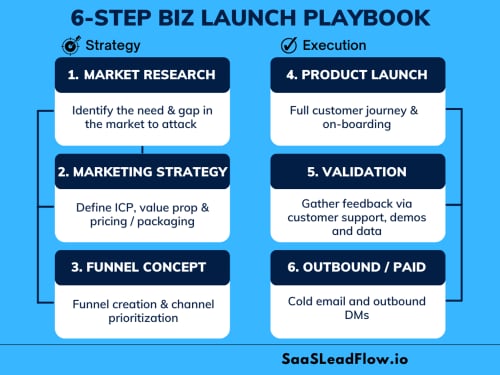Issue No. 20
How to start marketing your SaaS
How to start marketing your SaaS, a 6-step guide with growth strategies from Mike, the SaaS Launch Partner.
Reading Time: 7 min

Source: DALLE, told to extract key phrases from this newsletter, create a prompt and using the style illustrative, colorful, futuristic create an image.
This week's main topic is how to start marketing your SaaS.
What you'll read this week
- How to get started with marketing
- 4 tips for consistent growth
- 10 proven growth strategies
- 2023 Wrapped
Enjoy!
I'm often amazed by SaaS developers turned startup founders.
We'll spend countless hours writing code, making plans for migrations, scaling, and more. But often, the same amount of time won't be spent on marketing.
This is surprising because having a product no one knows about doesn't bring in the Stripe notifications.
Say 👋🏻 to Mike, the SaaS Launch Partner
That's why I reached out to Mike, the "SaaS Launch Partner," for this week's newsletter. I've been following Mike for a while now, since we've had similar trajectories, but his took him to focus on marketing.
Smart guy, Mike.
Mike has helped dozens of SaaS companies with marketing, including his first exit in October 2023.
He consistently posts about what it takes to get started with marketing and be successful.
You'll notice that his principles are solid and not flash in the pan. They are marketing principles you can take to the bank.
How to get started with marketing
Just like a product, you need a roadmap for marketing. Mike offers this excellent playbook, which, if you think about it, if you've at least started validating your product, you've been doing #1 already.
His steps:

1. Market Research
You're a builder. You've got an idea. But do you see the market talking about the problem? Are people hitting your landing page and giving you their email address?
There are many ways to do market research.
- Talk to people who you think would benefit from your idea
- Find them online, on Reddit, in forums, and in Slack communities. Are they talking about it there?
- Read product reviews and see what people complain about.
If you spend a little time doing this, you'll refine and improve your idea and know you're onto something.
Now, it's time to get specific.
2. Marketing Strategy
Mike isn't talking about how you're going to market but what you're going to market.
- Who are you selling to specifically? Can you define an ideal customer profile?
- What is your unique value proposition?
- How will you position your product via pricing and packaging?
The critical thing to realize is that you can do many different combinations.
You could shoot for a premium offering for a specific niche or go mass market with a lower price point.
It's up to you and the type of company and product you want to build.
Don't skip this step because it'll influence everything from here on out.
3. Funnel Concept
If you're new to marketing, a funnel is marketing talk about potential customers first becoming aware of you, to when they purchase.
Marketing Funnel
You can think of a marketing funnel in three stages with different focus, activities, and goals for each one.
- Top of Funnel (ToFu)
- Focus - Awareness and outreach
- Activities - Content marketing, SEO, social media posts (to your ICP, not #buildinpublic), and broad advertising
- Goal - Build brand and product awareness
- Mid Funnel (MoFu)
- Focus - Consideration and evaluation
- Activities - Email marketing, targeted content (like webinars, white papers, comparisons, etc), and retargeting ads
- Goal - Nurture leads by providing more specific information and addressing their needs
- Bottom of Funnel
- Focus - Conversion and purchase
- Activities - Personalized email campaigns, product demos, free trials, and sales calls.
- Goal - Encourage the final decision to purchase and close the sale
Marketing Channels
The other aspect of a funnel is in what channel, specifically how you'll advertise.
I recommend everyone read the book Traction; it covers the 19 marketing channels out there. Everything from physical media to digital.
For most SaaS companies, you'll focus on digital channels, social media, email, SEO, content marketing, and online ads. Don't forget word of mouth and cold calling!
4. Product Launch
You've got your strategy; it's time to get it out there.
The key here is understanding your customer's FULL journey (from hearing about you to onboarding).
Fun fact: you can launch more than once. So don't sweat it if you're first launch doesn't blow everyone out of the water.
Remember, there are 8 billion people out there. Most won't hear about you on launch.
5. Validation
Feedback, feedback, feedback. I'm a bit passionate about this subject.
But I'm not the only one.
Now that you've launched, start getting feedback and acting on it. This should be a constant cycle for growth, something you do by default.
Where can you get feedback?
- Ask for it, email new users as the founder
- Setup sales demos and ask for feedback
- If people stop using your software, reach out to them and ask
- Usage metrics: are people using your software as expected?
There are many ways to start sorting out what's working and what's not.
6. Outbound / Paid
Now that everything is in place, it's time to ramp things up.
For Interweave, outbound (email and DM's) is where I plan to start, and at my last startup, which had an 8-figure exit, outbound was the reason for 90% of sales.
Many want to do SEO only or skip straight to paid ads.
But the reality is that SEO takes time, and paid ads w/o marketing feedback could be better spent.
Cold DMs give you a shot to TALK to someone. That's gold.
And then keep iterating
It may sound like a lot at first. But honestly, just like learning to program, you just take a bit at a time and keep iterating.
You won't have a perfect landing page on day one.
Your DM's will likely make people cringe at first.
But with time, your marketing will improve.
Or you can ask someone like Mike, who's always down to talk.
10 Proven Growth Strategies Guide
If you want more from Mike, he's got a great guide on growth strategies.
In fact, it's what made me decide to reach out to him.
You can get his guide on proven growth strategies for free here.
Four tips for consistent growth
Mike has primarily bootstrapped his own SaaS over the last 7 years and says these are the 4 key areas of focus for consistent growth
1️⃣ Be Smart with Spending:
Think of your startup's marketing budget as your monthly budget. Spend wisely on things that give the most value. Focus on growth methods that are not expensive AND drive impact (i.e., users/revenue).
2️⃣ Aim for Steady Growth
Instead of spending all your energy to go viral or grow super fast, aim for growth that builds daily / weekly / monthly. You're planting seeds that might not be visible, but they will grow with consistency and persistence (follow-up!).
^^^ Note from Bryan - One of the reasons I ❤️ bootstrapping is it emphasizes steady growth over do-or-die growth at all costs. The VC world has been guilty
3️⃣ Learn From The Data
Every time you try a new growth strategy, measure the output and results. Building a company is an experiment. You need to make hypotheses and then test them. Use the data to get smarter about what you should do next.
4️⃣ Stay Flexible and Adapt
The tech world changes fast, and people make decisions irrationally. Make sure you get feedback and change routes as the market tells you to. Don't get stuck doing something because it worked 5 months ago.
Putting yourself and your company out there is an uncomfortable feeling. But if you don't advocate for your business, then nobody will. Start small, stay consistent, and you'll be ahead of 99% of people.
That's all from Mike. I hope you found this helpful; if you want more from him, he's on X, and his site is https://saasleadflow.io.
2023 Wrapped
Usually, at the end of my newsletters, I share how my startup is doing. But my co-founder and I took much of last week off.
So, instead, here's a quick excerpt from my 2023 Wrapped article I posted yesterday.
“Your life is perfectly designed for the results you’re getting.”
My pastor said those words last year on January 1st, 365 days ago, and it really struck me.
On paper my results were good.
- Good and happy relationships with my family and friends
- CTO of a startup in an exciting field
- High paying salary
What more could you want?
But with all this there was:
- Stress, startup life can be really hard, and the startup I was with had really misstepped a few years ago, and I was left holding the bag
- Health issues, I started 2023 trying out being gluten free because I’d been dealing with odd joint pain out of no where, I’d find that each morning when I woke up I could barely make a fist for the first few hours. When I’d do weight lifting, my favorite exercise, my elbows, wrist, and shoulders would get inflamed.
And frankly, being CTO, those were old dreams. Achievements I’d previously wanted.
I came to realize I had successfully designed what I wanted, achieved it. But forgot to keep designing as life changed.
So like any project, I sat down and started figuring out where I wanted to be, to start with the goal in mind.
If you enjoyed that, you can read the rest here.
Join the ProductFoundry Newsletter
Signup for insights into making great SaaS products and companies.